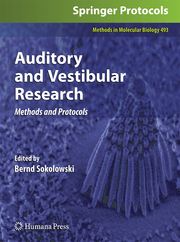-
Zusatztext
-
Hearing is a sensory modality critical to both language and cognitive development. In its absence, and without sensory input through another modality, such as the manual/visual modality of sign language, cognitive and language development can be severely impaired in the earliest formative years of a child. In its endeavor to d- cover the mechanisms underlying audition, the ?eld of auditory science has provided rich comparative physiological studies, allowing insights into both the micromecha- cal and electrochemical world of this system. For many years, the auditory/vestibular sciences have been in?uenced by the discoveries of electrical engineers and sensory physiologists, who have provided insights into the functions of this dynamic system. The early discoveries in these ?elds, as well as advancements in microprocessing and materials technologies, provided a means whereby hearing could be regained partly through the use of a bionic device, known as a cochlear implant. Presently, this device and the auditory brainstem implant are the only ones to prosthetically replace brain function. With the advent of molecular biology tools, such as RT-PCR, the auditory and vestibular ?elds have made great strides in understanding the genetic basis for various hearing and balance disorders over the past ?fteen to twenty years. These technologies permitted the discovery of genes that control inner ear structure and function by ov- coming the hurdle of working with small amounts of tissue, as found in the inner ear.
-
-
Kurztext
-
While early studies of the auditory/vestibular sciences provided insights into the anatomy and neurophysiology of these systems and produced a prosthetic cochlear implant, the rise of molecular biology now permits a clear examination of the genetic basis for various hearing and balance disorders. In Auditory and Vestibular Research: Methods and Protocols, specialists in the field describe current RNA, protein, and imaging protocols that have provided insights into genetic regulation as well as a greater understanding of the genes and pathogens involved in diseases of the ear. This overview utilizes both mammalian and non-mammalian animal models as well as techniques applicable to clinical studies in order to best provide an up-to-date perspective on basic research. Written in the highly successful Methods in Molecular Biology series format, chapters include brief introductions to their subjects, lists of the necessary materials and reagents, step-by-step, readily reproducible laboratory protocols, and Notes sections, highlighting tips on troubleshooting and avoiding known pitfalls. Comprehensive and cutting-edge, Auditory and Vestibular Research: Methods and Protocols is an ideal guide to the field and a useful tool for exploring genes and proteins in other systems as well, especially systems in which tissues are scarce and a comparative approach lends itself to discovering the underlying causes of human disorders.
-
Detailansicht
Auditory and Vestibular Research
Methods and Protocols, Methods in Molecular Biology 493
ISBN/EAN: 9781617379390
Umbreit-Nr.: 1131280
Sprache:
Englisch
Umfang: xii, 428 S., 48 s/w Illustr., 13 farbige Illustr.,
Format in cm:
Einband:
kartoniertes Buch
Erschienen am 20.01.2011
Auflage: 1/2009


